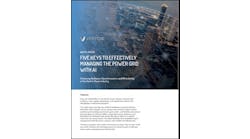Information Industrialization: Digitlizing Business Relationships for Energy Companies
Large-scale uncertainty, regulation and shifts in the competitive landscape are placing enormous pressure on energy firms’ existing operating models. In this article, Rashed Haq of Sapient Global Markets, discusses an approach for “information industrialization” to help energy companies more effectively compete and thrive: harnessing modern information technology and adopting lean operating principles to create integrated, inter-company workflows across the energy value chain.
The energy markets have experienced large-scale uncertainty over the last five years, driven by the dichotomy of a dramatic increase in supply from shale and renewables, and declining demand. Unprecedented midstream investments have created infrastructure changes, and the competitive landscape is shifting for traditional and non-traditional players caused by supply changes, regulation and new opportunities. The arrival of nimble competitors is eroding the revenues of established players, while stronger marketing and trading arms from midstream or downstream players are also altering the competitive backdrop.
Technological advancements, such as the adoption of consumer technologies in the corporate world, are driving the commoditization of big data, analytics and infrastructures in the cloud. At the same time, mobile apps are creating higher user expectations for enterprise applications to be more accessible, intuitive and responsive.
With an existing model that no longer operates efficiently, energy companies must transform the way they operate their businesses to deal with these unprecedented changes. A key problem is the high cost and inefficiencies each company must endure when building its own platform of processes and systems for functions that do not create a competitive advantage. Similar to the banking industry, energy companies need to undergo a transformation of their own by leveraging shared platforms, or business utilities, across companies that improves both inter-company communications and efficiency in order to thrive over the long term.
This transformation, referred to as “information industrialization,” is the use of technology innovation to fundamentally improve efficiencies across an entire industry. It replaces manual processes and paper trails with the sharing of information and resources in a digital environment to drive efficient division of labor and growth for all participating organizations. This is not unlike the automobile industry’s transformation in the 1950s when parts manufacturers were organized as separate companies to serve multiple carmakers.
Harnassing Technology Flow…
Business utilities are at the core of the information industrialization movement in numerous industries. These utilities are designed to carry out business functions for multiple companies, because there is no strategic advantage for each company to do these business functions themselves.
One example is payroll in the United States: a significant percentage of payroll is processed through a few providers, such as ADP, because their services are much more cost effective than if each company were to set up its own payroll processing function in-house. What’s more, the quality of the service and the additional features that ADP offers are more advanced and extensive than companies would be able to justify developing internally. This is largely due to the fact that ADP can leverage economies of scale by serving multiple companies.
For energy companies, business utilities can provide operational and transaction management services in which certain functions and associated infrastructure are moved outside of the company and into the utility to handle. The simplest case for leveraging business utilities is one in which communication between two companies is required. The different types of communication are:
- Vertical communication: between customers and suppliers, e.g., nominations sent from shippers to pipeline operators
- Horizontal communication: between peers, e.g., netted trade confirmations
- Star-like communication: with pooled interdependency rather than linear dependency, e.g., Brent, Forties, Oseberg and Ekofisk (BFOE) trading window in the North Sea
Many companies are already using outsourcing and software-as-a-service (SaaS) models. Outsourcing is an allocation of specific business processes of a company to a specialist external service provider, eliminating the need for companies to allocate staff to perform some or all aspects of the function internally. SaaS is a software distribution model in which applications are hosted by a vendor or service provider and made available to a company’s employees over a network, typically the web.
But business utilities go well beyond outsourcing and SaaS models by providing a resource-sharing information system and all associated processes. They link multiple firms that may be peers, or customers and suppliers, to carry out a common function by facilitating the efficient exchange of information. Participating organizations share the cost of expensive assets such as IT systems and leverage the economies of scale by consolidating the process execution. Business utilities perform transaction processing and reporting, for example, by providing only the necessary data from companies’ internal systems through automation— particularly information that needs to be exchanged, such as nominations, confirmations or invoices.
Business utilities for the energy industry
Business utilities for the energy industry can connect information among producers, traders and asset operators. The business utility platform depicted in the graphic above connects shippers and operators to exchange data across the energy logistics value chain. In this example, a trading organization connects to the business utility to send trade confirmations (to be sent to counterparties), and once scheduling is done, it forwards all nominations for all modes of transport.
These will be sent to the respective operators, such as pipeline, terminal and rail companies or marine vessel companies. Their confirmations come back through the utility.
Similarly, any associated inspection or agent nominations are sent to and received via the utility. Finally, invoices from each service provider are passed through the business utility back to the trading organization. This connects multiple companies across the value chain through a single network to efficiently exchange the information necessary to perform multiple business functions. In essence, the utility operates as a data exchange that receives information and disperses it to where it is needed, when it is needed.






